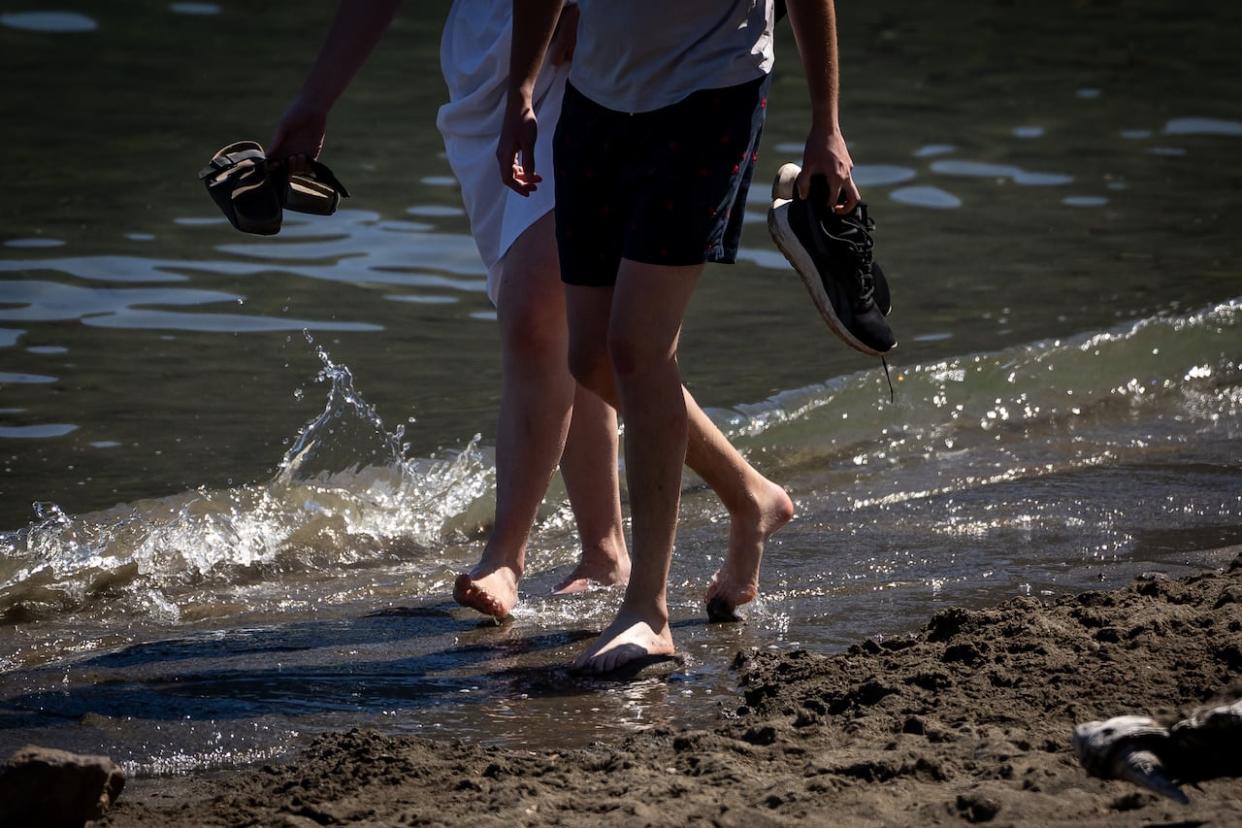Heat-related emergency calls spike in B.C. as temperatures soar

Health officials have responded to dozens of heat-related calls in recent days, as about 20 heat warnings are still in effect for some parts of British Columbia.
Amid the prolonged heat wave, the number of active wildfires in the province has jumped by more than 30 in the last 24 hours as forecasters warn of a risk for high wind and dry lightning in the province's north.
While heat warnings have been lifted across Vancouver Island, the South Coast and the Lower Mainland, they remain in place for the southern Interior, where high temperatures are expected to last into Thursday.
Nearly 40 communities set daily temperature records across B.C. on Tuesday, according to Environment Canada. The temperature hit 40.6 C in Kamloops, shattering the 38.6 C record set in 2015. Kelowna also set a new high of 39.3 C.
Lytton, which is often the hottest place in Canada this time of year, hit 42.5 C.
Several cities in the B.C. Interior and Kootenays including Lytton, Nelson, Kamloops, Kelowna, Vernon and Cranbrook are expected to break records again Wednesday, with forecasts calling for temperatures between 37 C and 40 C.
In an email to CBC News, B.C. Emergency Health Services said it had recorded an uptick in calls for medical emergencies related to the heat.
From Friday to Monday, it said, it responded to 78 "heat-related patient events" in all regions of the province.
Caution urged when exercising
With the heat set to linger in many parts of the province, paramedic public information officer Brian Twaites encouraged people to do what they could to cool living areas, including covering windows and turning on fans or other available cooling devices indoors, and wearing hats, sunscreen and staying in the shade outdoors.
Dr. Michael Koehle from the University of B.C. School of Kinesiology said exercising during a heat wave risks exertional heat illnesses ranging from "severe and dangerous" heat stroke to milder heat exhaustion with symptoms including headaches, fatigue and dizziness.
"Typically, you can manage that by stopping exercise, cooling down, and having some cool fluids to drink," said Koehle.
He said it was important to check the humidex level, which takes into account of both temperature and humidity, before exercising outdoors.
Most people usually feel uncomfortable when the humidex is above 30, he said.
Metro Vancouver is also currently under an air quality advisory for ground level smog, which will remain in place until further notice.
Koehle said that unlike smoke-related pollution, the smog is caused by ozone, a gas created on hot days when sunlight reacts with nitrogen dioxide and volatile organic compounds.
Ozone can irritate lungs, making people cough, feel short of breath or tight in the chest, said Koehle. He said smog can be highest on hot sunny days between noon and early evening, and air quality improves in the early morning or late evening.
Wildfire situation
As of Wednesday morning, the B.C. Wildfire Service (BCWS) was tracking 131 active wildfires, up from 98 the day before.
The service's map shows a cluster of about two dozen new fires sparked in the Cariboo region west of Quesnel, where Environment Canada's forecast says Wednesday's temperature will peak at 31 C with risk of a thunderstorm.
"After seven consecutive days of extreme heat, forest fuels are more susceptible to new wildfire starts," the BCWS said in an update posted online.
Two wildfires of note — meaning they are either highly visible or pose a threat to public safety — are now burning in northwestern B.C.
The BCWS says smoke from the 1.3-square-kilometre Little Oliver Creek fire will be visible from Highway 16 and the Terrace, B.C., area, while the 2.4-square-kilometre Hook Creek fire is burning out of control near the Yukon boundary and is visible from the Alaska Highway.
Highway 77 — a 138-kilometre road that starts just northwest of Fort Nelson and runs north to the Northwest Territories — closed due to a wildfire on Tuesday evening and remained closed until early Wednesday afternoon, according to DriveBC.
In a 1 p.m. MST update, the traffic service said while the road has reopened, drivers should not stop due to the wildfire risk.
Personnel are constantly monitoring and assessing conditions, and resources are deployed to areas of highest risk, the BCWS said.
Meanwhile, an evacuation order remains in place for a community in northeastern B.C.
The Fort Nelson First Nation issued the order on Tuesday for the remote Kahntah Reserve, about 115 kilometres southeast of Fort Nelson, telling residents and visitors they must immediately leave by boat.
Campfire ban coming soon
A provincewide campfire ban is also coming into effect at noon on Friday, with the sole exception in B.C. being the Haida Gwaii Forest District.
The ban is being put into place because of the risk of increased wildfire, as a cold front is forecast to sweep across northern B.C. on Wednesday bringing strong winds, thunderstorms and the potential for dry lightning.
Southern parts of B.C. could also receive wind and dry lightning, the B.C. Wildfire Service said.


